Q: About light intensity.
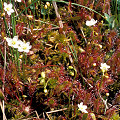
Drosera anglica
in full sun
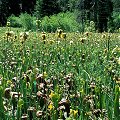
Darlingtonia
in full sun

Dionaea
in full sun
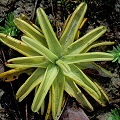
Pinguicula caerulea
in full sun
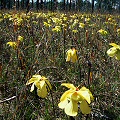
Sarracenia alata
in full sun
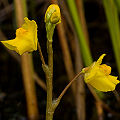
Utricularia macrorhiza
in full sun
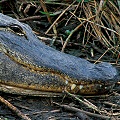
Alligator
in full sun
A: As I have said earlier, it is critical, absolutely critical, that
you give your plants enough light.
If you give your plants enough light, they'll have lots of energy and be very strong. And if they are strong,
they'll be able to withstand other horticultural errors. Are you using too much water? A well illuminated
plant won't care as much! But a plant in dim conditions will respond to deoxygenated soil by collapsing faster than
a balloon on a cactus.
In the next FAQ entry I talk about light quality, but first I want to talk about light intensity. Because that is
what you need---intense, Intense, INTENSE light.
Carnivorous plants in the wild often grow under full sun. There are exceptions, of course, but certainly the plants that
a beginner is likely to have, such as Venus flytraps, sundews like Drosera capensis,
and pitcher plants like Sarracenia, all like full sun.
If you have a brightly lit greenhouse without much whitewash on it, you should be fine if you can supply 10-16 hours
of sunlight. If you are lucky enough to live in a climate where you can grow your carnivorous plants outdoors, 10-16 hours
of direct, unfiltered sunlight is your prescription, too.
But what about the indoor grower? This poses a major challenge. It is unlikely that you will have a room that gets enough
bright sunlight, so you will need to supply artificial lighting. And you must supply a lot of it! Light filtering
through a window is not enough, unless maybe we're talking about an atrium which is so bright you blink for a few minutes
every time you enter it.
People constantly email me
questions like, "Will my 2-bulb fixture produce enough light if I use it with some filtered sunlight?" How can I possibly know? It
depends upon how close to the plants your bulbs are, how clean your windows are, and a gadzillion other things. It would be great
if we all owned simple instruments to measure light intensity (similar to how we all have thermometers for measuring temperature).
I would be able tell you just how many lumens or foot-candles you need. But we don't. So you're out of luck.
Ah, but not entirely out of luck, for you have found my FAQ and I strive to help you. So in desperation I have created a
crude, oh so crude, calculator for you to measure if you have even remotely acceptable light intensities for your
carnivorous plants. But in order to let me help you, you must use a camera that has a light meter.
It doesn't matter if it is digital or for film. Make sure you
know how to use it, since I won't tell you. You won't be taking any actual pictures, you'll just be using the light meter.
Using Barry's Cool Light Calculator.
Step 1: Arrange your entire growing situation exactly as you would have it with plants
installed. Turn on the illumination, or open the curtains, or whatever you're planning on doing to provide light.
Step 2: Lay a white sheet of paper flat in the growing area. Make sure it is at the same height as
where the plants' leaves would be (or are), and not at the bases of the pots. Use a big sheet of nice, clean, nonglossy paper.
There should be no
lines or writing on it--just a blank sheet of white paper.
Step 3: Set your digital camera's sensitivity
to 100. If you can only set it to some other speed, like 200 or 400, you can do that instead. My calculator will take care of
that for you.
Step 4: Set your camera lens to F8.
Step 5: Looking through the camera, get close enough to the piece of white paper so that it
fills your field of view. It doesn't matter if it is in focus, how far you are from the paper, or what kind of lens you use.
Just make sure that the paper fills
the entire field of view, and that you aren't blocking the light sources as you're doing this. If you are shooting through
the wall of a terrarium, make sure the glass is clean and free of condensation.
Step 6: Verify that you're still on F8 (it can change if you're using a zoom lens). Take a look
at the exposure time your camera is setting for the picture, like 1/30th second, or 1/2 second, or whatever. Record the film
speed/detector sensitivity you used and the exposure time your camera recommended.
Step 7: Look at the table below. Select the film speed/detector sensitivity column that
corresponds to what you used. Then, find the row that corresponds to the exposure time your camera recommended.
At the intersection of your row and column, you can find a percent number. That percent number is the
"Barry Factor", named after the person who wrote this FAQ.
| Determining the Barry Factor | |||
|---|---|---|---|
| 100 | 200 | 400 | |
| 1/4 | 3% | 2% | 1% |
| 1/8 | 6% | 3% | 2% |
| 1/15 | 13% | 6% | 3% |
| 1/30 | 25% | 13% | 6% |
| 1/60 | 50% | 25% | 13% |
| 1/125 | 100% | 50% | 25% |
| 1/250 | 200% | 100% | 50% |
| 1/500 | 400% | 200% | 100% |
Suppose you used a camera sensitivity/film speed of 200, and at F8 you measured an exposure of 1/125th of a second.
Looking at the table above, I see that your Barry Factor is 50%. That means that your proposed lighting situation provides only
50% (or 1/2) as much light as I am giving my plants. If your Barry Factor is smaller than 25%, I'm feeling sorry for
your plants.
I'm not saying exactly what is an adequate Barry Factor. My wife grows her Pinguicula and
Nepenthes with a Barry Factor of around 70% and does just fine. But I grow
Sarracenia, aquatic Utricularia, and
Dionaea (Venus flytraps), and they need a lot of light.
A few parting observations. I calibrated my Light Calculator table above using light bulbs about two years old. These are overdue
for replacement! New fluorescent light bulbs are brighter than old ones, which is something to bear in mind if
you're scrabbling for photons. Second, even my bright terrarium is positively dim compared to full sun. Full sun has a
Barry Factor of about 370%! Even my co-called bright terrarium is dim, dim, dim.
If you are relying on ceiling-mounted lights to illuminate your plants and you have a Barry Factor of 6%,
kiss the plants goodbye. That's not enough light, not by a long shot.
Page citations: Rice, B.A. 2006a; personal observation.